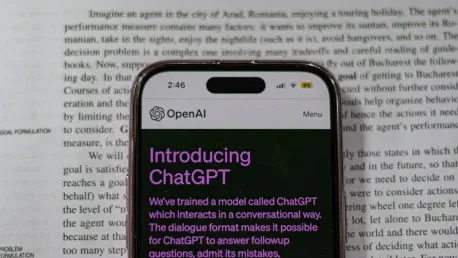Before AI content generation, marketers had a hard time making good content. They had to spend a lot of time researching, writing, and editing to deliver valuable material and stay competitive. With the introduction of ChatGPT and other AI content generators, things changed.
These AI tools use natural language processing and advanced algorithms. They help produce a lot of content—quickly. As a result, 61.4% of marketers and individuals looking to improve their content development use AI tools to make the process more efficient. These tools have also made content creation accessible to more people. Before, only big companies could afford content teams, but now, even micro-organizations can benefit from smart technologies.
With the right training, AI can give a personal touch to content development. It can copy a specific writing style or analyze data to make material that appeals to specific audiences. ChatGPT is among the most sophisticated generative AI tools, and since it has a free version, it has a huge amount of daily input. So we could say it is one of the most trained models. But, since its release, numerous tools have been launched and business owners have plenty of choices.
So let’s explore how you can produce more content without sacrificing quality by analyzing the most popular artificially intelligent generators.
How AI Can Be Utilized in Content Creation
While AI is a valuable asset, we mustn’t forget that it complements rather than replaces human input. All AI-generated material needs human supervision to ensure quality and relevance.
Here are several ways in which AI can be effectively integrated into content development:
Idea Generation: Produce new content ideas super fast and support your team’s brainstorming sessions.
Outline Drafting: Arrange your ideas for articles and other written materials in a clear and structured way with lightning speed.
Rephrasing Content: AI tools are great at rephrasing. Also, they can offer you a desired tone to get you started on a paragraph.
Overcoming Writer’s Block: We all get writer’s block at times, but now, with the help of these smart algorithms, we can overcome it more easily than ever. Generate sentences or paragraphs with one click—just never skip fact-checking and editing.
Repurposing Content: Algorithms make it easier for publishers to transform blog posts into social media updates or other formats.
Creative Writing: AI can make unique verses, but its poems are far from art. Still, short stories come out interesting. It can give a writer the much-needed nudge when deadlines loom over their head.
So, AI can perform all of these tasks, and more, with great efficiency and speed (and a sprinkle of artistry). However, human oversight is still essential if you want the best results. Here’s how you can make AI-generated content sound more human:
1. Understand Your Audience
AI tools can analyze data and put out content based on algorithms, but they can’t always capture the subtleties of human experience and emotions. First, develop comprehensive audience personas to understand your readers’ preferences, needs, and pain points. Next, leverage audience insights from social media and website analytics to refine your collateral strategy. Regularly seek and integrate feedback from your audience to keep your content aligned with their interests.
Recommended tools:
Google Analytics: This software watches and studies website traffic and user activity. It gives you information about the people who visit your site, like their age, interests, and how they interact with your content. This information is useful for creating detailed descriptions of your audience because it shows you what they like and how they behave on your site.
HubSpot Analytics: HubSpot also provides detailed analytics that gives you important information about how many visitors become customers, which content performs the best, and how effective your marketing is. You can use this information to improve your strategy and personalize AI-generated content to match what your audience likes.
2. Infuse Personality and Voice
A distinct personality and voice make content more engaging and relatable, setting it apart from generic AI outputs. Establishing a clear, consistent voice for your brand will reflect its values and personality. To do that, you need to write as if you were having a conversation with your reader. Use informal language and personal anecdotes where appropriate. Never underestimate the effect of some light humor, sprinkle in emotion and relatable experiences to connect with readers on a personal level.
Recommended tools:
Copy.ai: A sophisticated program that can generate high-quality marketing copy, blog posts, and other content in various tones and styles. Users can select from different tone options such as friendly, professional, or conversational to make sure it reflects their brand’s voice.
Jasper (formerly Jarvis): Predecessor of ChatGPT, Jasper is known for creating different types of content using a wide range of voices and tones. The platform gives users templates they can customize to match their brand’s unique style. They can also give specific instructions on adding humor or personal stories.
3. Humanize the Content
AI can make accurate and structured material, but it often lacks the warmth and nuance that makes it truly engaging. To humanize your content, integrate personal anecdotes and stories that reflect real experiences and emotions. Include diverse perspectives by featuring quotes and experiences from various experts and individuals to add depth and authenticity. Additionally, highlight unique observations that come from human experience, making your content more relatable and compelling.
Recommended tools:
Writesonic: This tool can quickly deliver first drafts of various texts like blog posts and ads. But it’s important for people to add their own unique perspectives to make the collateral more interesting and trustworthy.
Narrative Science: This tool can turn data into easy-to-understand stories. It’s great for organizing content from data. To make the output more relatable, it’s best to include personal stories and different viewpoints.
4. Focus on Quality over Quantity
When creating content that resonates with readers, focus on quality over quantity. Instead of producing generic material, concentrate on developing well-researched, high-quality content that connects on a deeper level. Start with drafts, then refine and edit them to enhance clarity, coherence, and emotional impact. Make sure your content offers real value and avoids unnecessary repetition or filler, ensuring that each piece is meaningful and engaging.
Recommended tools:
Grammarly: This tool checks grammar, spelling, style, and tone. It can improve AI-generated drafts by making them clearer, more coherent, and more emotionally impactful, ensuring high-quality content.
Hemingway Editor: This tool reviews writing for readability and style, focusing on finding complex sentences and offering simpler alternatives. This helps users improve AI-created drafts by making them easier to read and more engaging.
5. Leverage Human Creativity
Gen AI is great at helping companies and consumers work together to create new product ideas and designs. Take advantage of AI and give your supporters tools to generate images, texts, and videos of their next favorite commodity. User-generated content is perfect for creating personalized versions of your marketing materials in an imaginative and affordable way. Not to mention it ends up strengthening your connection with your audience.
Recommended tools:
Adobe Firefly: This tool helps with unique designs by producing visual material and graphic elements. It can inspire unique ideas and provide assets that complement the written content. However, it’s important to remember that human imagination is necessary for turning these components into cohesive and original ideas.
Runway ML: This tool suite includes various AI features specifically designed for creative tasks like editing videos and images. Although it supports brainstorming and producing original content, human input is still crucial for shaping and perfecting the final outcome.
6. Ensure Ethical and Accurate Content
You must publish reliable content to build a strong relationship with your audience and show your commitment to honesty. To do this, fact-check and verify your sources before sharing to avoid spreading false information. For example, ChatGPT faced GDPR hurdles over data accuracy concerns earlier this year. That’s why it’s crucial to handle user data and personal information carefully to comply with privacy rules. Also, be aware of potential biases in AI-generated content and strive to produce fair and inclusive material that represents various viewpoints.
Recommended tools:
Full Fact: A fact-checking tool verifies information to ensure that content created by AI is accurate and free from misinformation.
Snopes API: This API allows you to access a database that contains verified information and can debunk myths. This resource is useful for checking claims and ensuring the veracity and ethical standards of your content.
7. Continuously Improve
Rules of creating content and using smart technology are always evolving. To keep up, it’s important to use analytics to track how well AI-generated content is doing and make changes based on real-world feedback. Knowing about deep learning and content trends is important to continue improving your approach. You should also regularly assess and level up your content strategy to include new insights and make sure your marketing collateral stays relevant and engaging.
Recommended tools:
Optimizely: An A/B testing platform allows users to try out different versions of content to find out which one works better. This helps make data-based decisions to improve and perfect AI-generated material.
VWO (Visual Website Optimizer): This tool helps you understand how different variations affect user engagement and conversion rates. It offers insights to improve your content strategy by providing A/B testing, multivariate testing, and heatmaps.
It’s important to use these tools effectively to ensure that AI-generated content connects with your audience, maintains a consistent and engaging tone, and continuously improves in quality and accuracy.
Conclusion
To produce more human-like AI content, we need to blend technology, creativity, and empathy. Understanding our audience, adding personality, focusing on quality, and using human imagination are all vital for making content that truly connects with people. While AI can help produce almost anything your business may need, human input is crucial for making compelling and influential material. When we combine AI’s abilities with human ingenuity, we can make pieces that build connections, inspire, and have a lasting impact.









